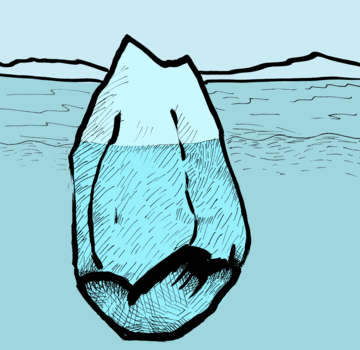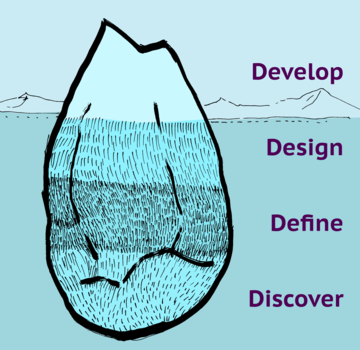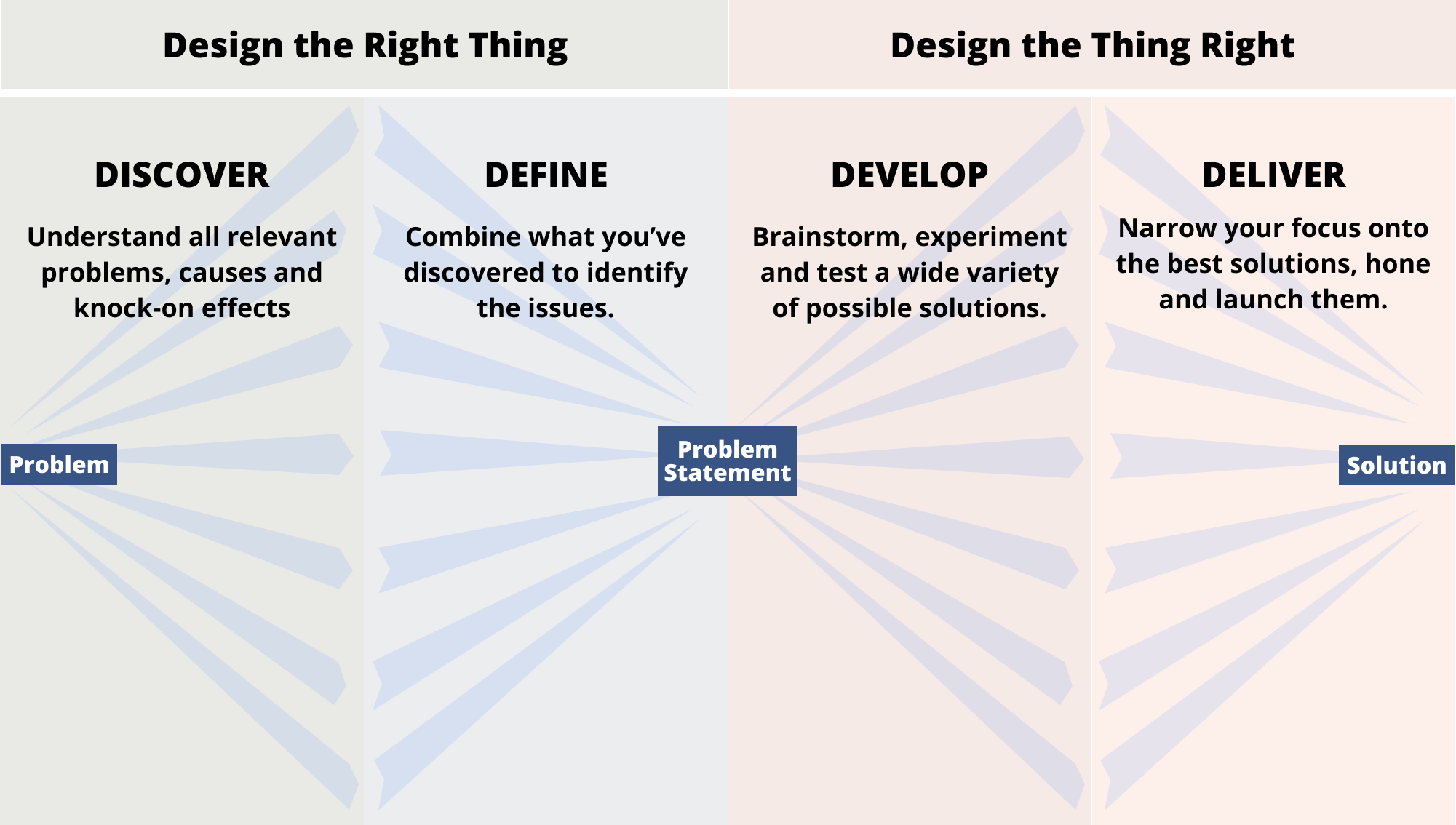UX through the development process
UX techniques applied throughout the development cycle that can improve product quality and team operation and reduce risk and development cost, with reference to the ‘UX iceberg’ and the double diamond method.
Timing is everything
A common problem encountered by most User Experience (UX) teams is being called upon too late in a project. This is often caused by a technology-focused mindset within the project that sees the User Interface (UI) as a development task which happens later within the project. From a purely technical point of view this is correct, but what this fails to account for is that the actual building is only about a quarter of the process that goes into creating an appropriate UI for a product. This issue is often described as the UX Iceberg.
The UX Iceberg

Only the tip of the iceberg is visible above the water.

A large portion of an iceberg is below the surface.

Beneath the surface lies the discovery, definition and design work which goes into building a good User Interface.
The UX iceberg is a great analogy as it effectively articulates the process that goes into building a good user interface and explains common misconceptions around user experience and user interface design. It’s only natural that people should focus on the interface design element of user experience: that’s the bit that you can see. Making a user interface without doing user research is like buying shoes without checking the size: you can but at some point it’s going to get uncomfortable...
If a designer was able to produce an attractive, intuitive and appropriate interface for a product without delving below the surface, simply by sprinkling some pretty design dust, then UX really would be magic. making a good user interface is a process.
To be confident of building a good UI, you have to start by understanding your users, from which you can work out what they need, what is working for them, what isn’t and where the pain points are. Once that’s properly understood, you can start to think about what needs to be changed and how. Once you know that, you’ve got your destination and can start to think about how to get from A to B.
To get a good UI, it needs to be geared to your audiences’ needs, expectations and preferences.
Fortunately, there are established design frameworks such as the double diamond process which are geared towards iteration and user-centred design.
The double diamond method

The double diamond process breaks the creation process into four stages in a manner that explains and highlights steps in the process.
- Discover: Understand the problem by speaking with the users who are directly affected
- Define: Analyse the data and define the key issue or opportunity to address
- Develop: Generate ideas and possible solutions to the problem
- Deliver: Validate the solutions that work and prepare the design for release.
The first two phases constitute the first diamond focusing on identifying and analysing the problem; the second diamond on designing and delivering a solution to that problem. Each of the diamonds breaks down into a two phases: a divergent ‘blue-sky thinking’ phase which focuses on open-mindedness creative thinking; and a convergent thinking phase that focuses on critical thinking and prioritisation and closure.
Discover
The discovery phase requires divergent thinking, an open mind. Don’t assume you know what the problem is, and don’t ignore aspects of the problem which you consider irrelevant or impossible to fix; such critical thinking should be done in the define phase. The purpose of this phase is to generate as much raw material as possible in terms of data, user insights etc.
If you are introducing an system to support a particular process across the institution, it is vital to understand what level of consistency currently exists. Do all departments and divisions have similar practices? Are these process carried out by comparable roles? Senior managers and stakeholders will give you the theory of the process, but in order to understand the practice you need to speak to users. The picture you get will from users will be more complex, messy and scary. It's important to realise that user research doesn't create complexity, but only identifies and articulates it, hence why it is vital to do at an early stage; ignorance isn't always bliss.
Methods
Audience Analysis
- Identify all the people who are involved in the process you are trying to improve.
- Organise your users into categories according to their involvement in the process (who does what, who decides what etc.).
User Research
- Collect information from each user group their view of the process (how it works, what works well, what doesn't, what ), exact methods here will vary but could be surveys, workshops, interviews, diary studies.
- Analyse and cross-reference your findings to build a picture of the totality of the process, even (especially) the bits beyond your control.
- Validate your findings by articulating then back to your users and ensure they recognise the picture you have drawn is accurate and revise where necessary.
Once you are confident you have a strong handle on the nature of the problem at hand, it’s time to progress to the define phase to apply critical thinking to the problem in order to prioritise and focus.
Define
Once you have a true picture of practice, then you need to start narrowing down and defining which aspects of the problem you are going to address. It is at this stage which you may need to make some hard decisions about scope. In most cases where a problem has been properly analysed, there is far more that could and perhaps should be done than is possible within the original scope of work. For example, if there isn't consistency in practice between different areas of your userbase, then implementing a system to applying a common process across the userbase risks being an expensive failure.
In this circumstance, your options are some or all of:
- Broaden the scope of the work
- Descope the usersbase (e.g. by only rolling out to certain departments)
- Descope processes or sub-processes
- Build greater flexibility into the system
- Review, revise and harmonise processes
To decide which is the best course of action, you need to understand the consequences of each. As with the Discover phase, senior managers and stakeholders will have a good overview of this, but to really understand the impact of each course of action, you need to ask the users. It is also likely that some of these options can be ruled out before asking the users (e.g. there is no budget to broaden the scope.)
Methods
You can make use of the audience analysis and user research methods used in the Discover phase, but this time your research objectives are different. You now want to know the impact of each course of action will be and what it would require to be successful. This will impact how you conduct the research, as there will be more focus on articulating hypotheticals as well as considering the current situation.
The end of the define phase brings you to the mind-point of the double diamond process and the conclusion of the problem definition phase. At this point you should have a clear problem statement based on solid user research and analysis that articulates exactly what problem you are trying to solve (and which aspects are out of scope). This should allow you proceed to developing and delivering a solution with a high degree of confidence that you are addressing the right problem. If this isn’t the case, you should consider further iteration on the problem definition, proceeding into development without a clear problem definition can prove very costly: define the problem first.
Develop
Now that we have a clear definition of the problem, we can switch again to divergent thinking, applying blue-sky thinking to solutions to that problem. This requires brainstorming and iteration.
Brainstorming plays a crucial role. This phase is all about generating and exploring potential solutions to the problem defined in the previous stage:
- Idea generation: Brainstorming sessions encourage the team to think creatively and come up with a wide range of ideas without immediate judgment or criticism.
- Divergent thinking: It promotes divergent thinking, allowing the team to explore various possibilities and innovative solutions.
- Collaboration: Brainstorming fosters collaboration among team members, leveraging diverse perspectives and expertise.
- Problem-solving: It helps in identifying multiple approaches to solving the problem, which can later be refined and tested.
- Engagement: Engages all team members actively, ensuring that everyone contributes to the solution development process.
By encouraging open and creative thinking, brainstorming helps teams to uncover unique and effective solutions that might not emerge through more structured or individual approaches.
Once you have some ideas that have potential, it time to test the quality and feasibility of these ideas with those best placed to judge: the users.
Prototyping
Iteration is key to the double-diamond process and especially so in the Develop phase. Best practice and design skills can only get you so far; testing ideas with users is the only way of knowing that your design solutions are heading in the right direction. As such, you want to test your ideas as quickly, cheaply and often as possible.
Prototyping is an essential part of the design process that helps you communicate ideas, validate concepts, and refine your design based on feedback and iterate quickly without spending too much time or money on full-fledged development. A prototype is a tangible representation of a design concept. It’s about showing, not just telling. Whether you’re building a simple sketch or a fully interactive mock-up, prototyping helps in several key ways:
- Visualise your ideas to help stakeholders understand and engage with your vision.
- Test usability and functionality to catch potential issues early.
- Gather feedback quickly and make changes with minimal cost and effort.
- Build team alignment by providing a concrete artefact for discussions.
prototyping is an iterative process:
- Articulate to users what your plans are as quickly and effectively as possible
- Collect feedback - what aspect do users find useful or difficult?
- Analyse - identify issues to be resolved and value to be protected
- Revise - change system to resolve issues, taking care not to regress valued aspects
- Iterate - do it all again
You should iterate on concepts until you are reasonably confident of committing your ideas to the expense of technical implementation.
Deliver
The delivery stage is more familiar to most people, as we’re now working on the final product, the bit of the iceberg above the water. As such, there’s less to say here as this is familiar ground to most. Iteration is still key in the Deliver phase, but the emphasis now is in narrowing the of scope changes; you don’t want to be making major changes to your product at this stage, as this will likely involve expensive re-work and put strain on budgets and deadlines. In addition, we also need to start communicating to users about the launch of the product.
Methods
- Usability testing: Test the final design with users to identify any issues.
- Iteration: Refine the design based on feedback and testing results.
- Launch planning: Prepare for the launch, including communication and user onboarding strategies.
In conclusion...
It may appear that the four-phase double diamond process sounds like more work, however it’s focus on defining the nature of the problem early in the process, and iteration and user feedback throughout the development stage ensures that the project has both a clear destination and a continuous course correction. It is these attributes that mean that it is likely to save time and money in the context of projects with any degree of ambiguity or creativity.


